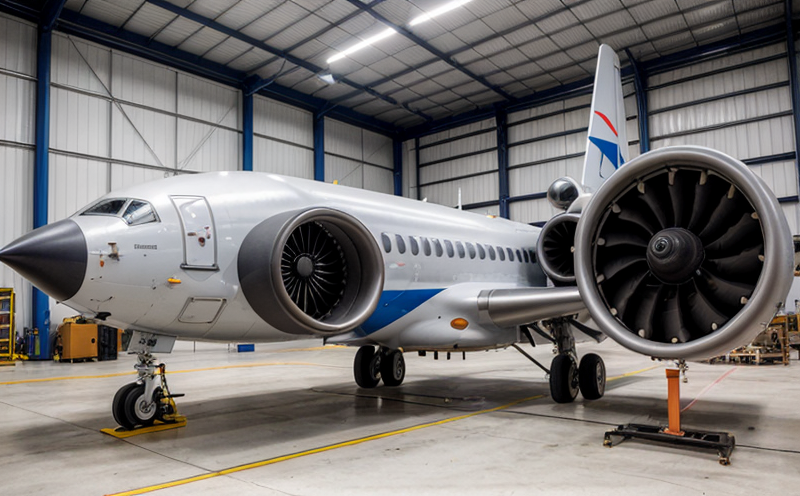Structural Vibration Damping Material Testing
In aerospace and defense applications, structural vibration damping materials play a crucial role in mitigating vibrations that can lead to premature aging or failure of components. These materials are designed to absorb and dissipate mechanical energy, thereby reducing harmful oscillations within structures subjected to dynamic loading conditions. The testing of such materials is essential for ensuring the integrity and longevity of aerospace and defense systems.
The process begins with selecting appropriate specimens that accurately represent the intended application. Specimen preparation involves cutting samples from bulk material according to predefined dimensions, which ensure consistent mechanical properties across all tested samples. Once prepared, these specimens undergo rigorous testing using advanced vibration analyzers capable of simulating real-world environments.
Testing typically includes frequency response measurement over a wide range of frequencies relevant to the expected operating conditions of the end product. This helps determine how well the damping material performs under varying loads and speeds. Additionally, durability tests may be conducted by subjecting the samples to repeated cycles of loading until they reach their fatigue limit or failure point.
Accurate measurement is critical for reliable results. Instruments used in these tests adhere strictly to international standards like ISO 16230-1 and ASTM E1847, ensuring consistency across different laboratories worldwide. Compliance with these standards guarantees accurate data interpretation and comparison between various materials being evaluated.
Real-world applications highlight the importance of this testing. For instance, in aircraft design, reducing structural vibrations can improve passenger comfort while extending service life by minimizing fatigue-induced damage. Similarly, in missile systems where precision is paramount, effective vibration control ensures optimal performance during launch and flight phases.
Testing methodologies vary depending on specific requirements but generally involve exposing the specimen to controlled levels of mechanical stress and measuring its response through displacement sensors, accelerometers, or strain gauges attached directly onto the sample. The data collected provides insights into how effectively each material absorbs energy and dissipates it safely away from critical areas.
Reporting involves documenting all measurements alongside relevant specifications regarding temperature range, humidity conditions, frequency spectrum analyzed, and any other pertinent factors affecting test outcomes. This comprehensive report serves as valuable input for design teams when selecting the most suitable damping materials for their projects.
Why It Matters
The aerospace industry demands precision and reliability from every component used in its vehicles, including structural vibration damping materials. Ensuring these materials perform optimally under extreme conditions is vital for maintaining safety standards and operational efficiency.
Vibrations can cause excessive wear on moving parts leading to increased maintenance costs and reduced overall system performance. By accurately testing these damping materials before incorporation into aircraft designs, manufacturers can identify potential issues early in the development cycle, allowing them to make necessary adjustments without compromising quality or schedule.
Compliance with regulatory requirements ensures that products meet industry expectations regarding safety and reliability standards set forth by organizations such as FAA (Federal Aviation Administration), EASA (European Union Aviation Safety Agency), and DoD (Department of Defense). This compliance builds trust among customers who rely on reliable performance from their suppliers.
Furthermore, successful testing demonstrates a company’s commitment to innovation and quality control which enhances brand reputation and market competitiveness. It also facilitates smoother interactions between stakeholders involved in various stages of product development, manufacturing, and deployment.
Applied Standards
The testing of structural vibration damping materials adheres to several key international standards that define the methodology for evaluating material properties under dynamic loading conditions. These include:
- ISO 16230-1:2018 - Guide for specifying and assessing performance characteristics of viscoelastic materials used in structural vibration damping.
- ASTM E1847-19 - Standard practice for determining the dynamic modulus of viscoelastic materials by mechanical means.
- EN 30265:2016 - Specification for viscoelastic damping materials used in aircraft structures.
These standards provide clear guidelines on specimen preparation, testing protocols, and data analysis techniques ensuring consistency across different laboratories worldwide. Compliance with these standards enhances credibility and confidence among clients regarding the accuracy of test results produced by Eurolab.
Eurolab Advantages
At Eurolab, we offer state-of-the-art facilities equipped with advanced testing equipment to conduct structural vibration damping material tests that meet all relevant international standards. Our experienced team of engineers provides expert advice throughout the entire process from initial consultation through final report delivery.
We pride ourselves on delivering accurate and reliable test results within tight turnaround times, allowing our clients to make informed decisions quickly based on solid evidence rather than guesswork. We also offer customized testing packages tailored specifically to meet individual customer needs ensuring maximum value for money spent.
Our commitment to quality is reflected in our certifications which include ISO 9001:2015 and ISO/IEC 17025 accreditation, signifying adherence to strict quality management systems and proficiency in technical competence respectively. These accreditations underscore our dedication to excellence and continuous improvement.
We collaborate closely with industry leaders providing insights into emerging trends and technological advancements within the field of structural vibration damping materials helping our clients stay ahead of competition through proactive strategic planning.





